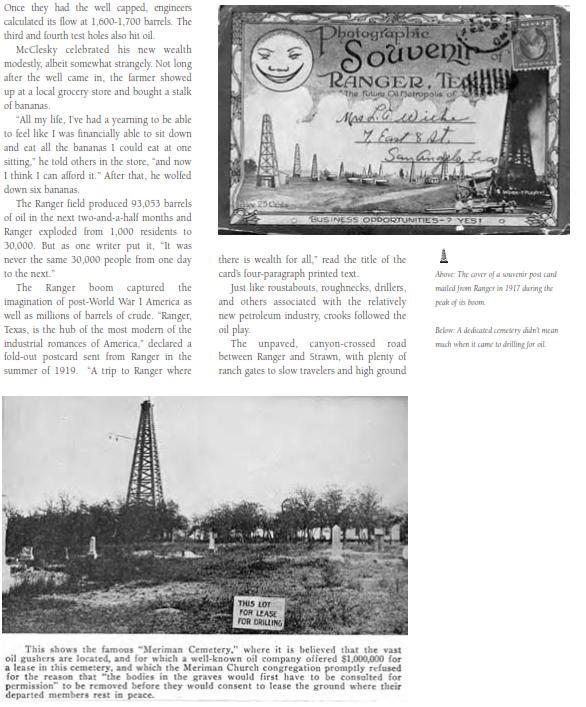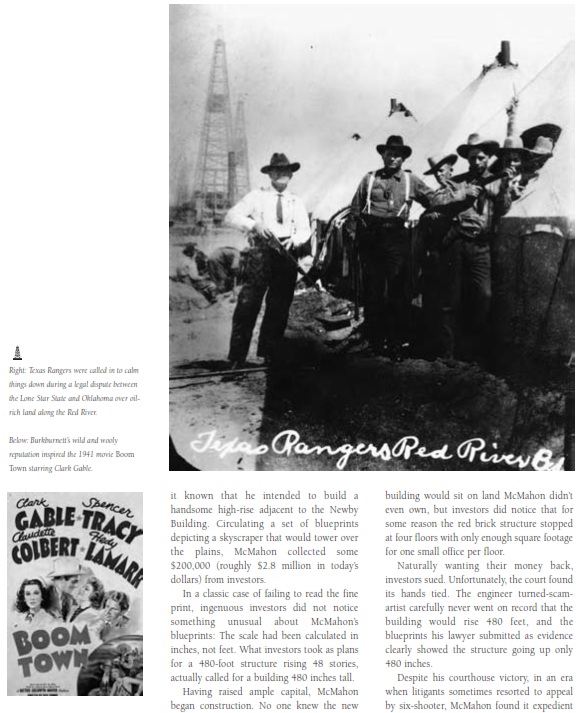CHAPTER 3
NORTH TEXAS
The shallow coastal salt dome wells had begun to play out, but the national demand for petroleum products had not. The railroads had begun refitting their locomotives to burn oil, and the Navy was rapidly doing the same with its ships. In addition to those large, new markets, as automobiles became more popular, the need for oil grew even more.
From 1902 to 1912, the number of automobiles in America went from 23,000 to 902,000. Truck production rose from zero to 41,000 during the same period. In response to that growth, the Texas Company opened a refinery in Dallas and in 1909 began producing what it called No. 4 Motor Gasoline from crude piped in from Oklahoma. Soon, the kerosene market had dwindled while the company sold every drop of gasoline it could refine.
In North Texas, geologists believed a formation known as the Red River Uplift had oil-bearing strata, but the shallow wells around Petrolia had produced only low yields. And when they did come in, discoveries tended to be either accidental or based more instinct than science.
"The most technically trained geologist could do little more than apply a good measure of horse sense in locating wildcat wells after attempting to decipher the significance of topographic features, paraffin dirt, mineralized water, and gas seeps," geologist John M. Vetter wrote for Oil Weekly more than a quarter century later.

"Damn the oil, I want water," Waggoner famously roared.
In 1902, the handful of residents at Beaver Switch petitioned for the community to be renamed Electra, in honor of Waggoner's daughter. Oil would soon electrify Electra, at least in the figurative sense.
On January 17, 1911, the Producers Oil Company hit oil on its fifth hole on the Waggoner Ranch. The company tried to keep its 50-barrel-a-day well secret, but that effort proved about as effective as stopping a rusty pipe from leaking. When a gusher drilled by Clayco Oil and Pipeline Co. blew in on April Fool's Day, sending crude shooting 100 feet into the air, yet another rush was on. The Electra field produced more than 21 million barrels of oil by 1914, its peak year. By then, the Waggoner Ranch had more than a hundred producing wells and the spread's owner wasn't quite as sour on oil as he started out.
Oil continued to be easier to come by than water. "Everybody here have (sic) to buy every drop of water they use," someone wrote on a postcard they sent from Electra in 1913. "Get it from Vernon. Ship it in."
Even though no oil had been found in Wichita Falls, the railroad town became West Texas's first oil and gas city. In 1915 the Wichita Valley Refinery Co. began operation in Iowa Park, the first oil refinery in Wichita County and the first in West Texas. Later that year, the Panhandle Refinery Co. opened in Wichita Falls. Both plants handled the still-modest oil production from the Petrolia field. Having that infrastructure in place proved fortuitous for Wichita County, where a boom that would capture the attention of the nation stood in the offing.
ROARING RANGER
One hundred-twenty-five miles southwest of Wichita County lay a small town on the Texas and Pacific Railroad named after the legendary Texas Rangers.
Awareness that oil might be found beneath the arid acreage around Ranger had developed five years before, when the Texas Pacific Coal Co. based at the mining town of Thurber in nearby Palo


























